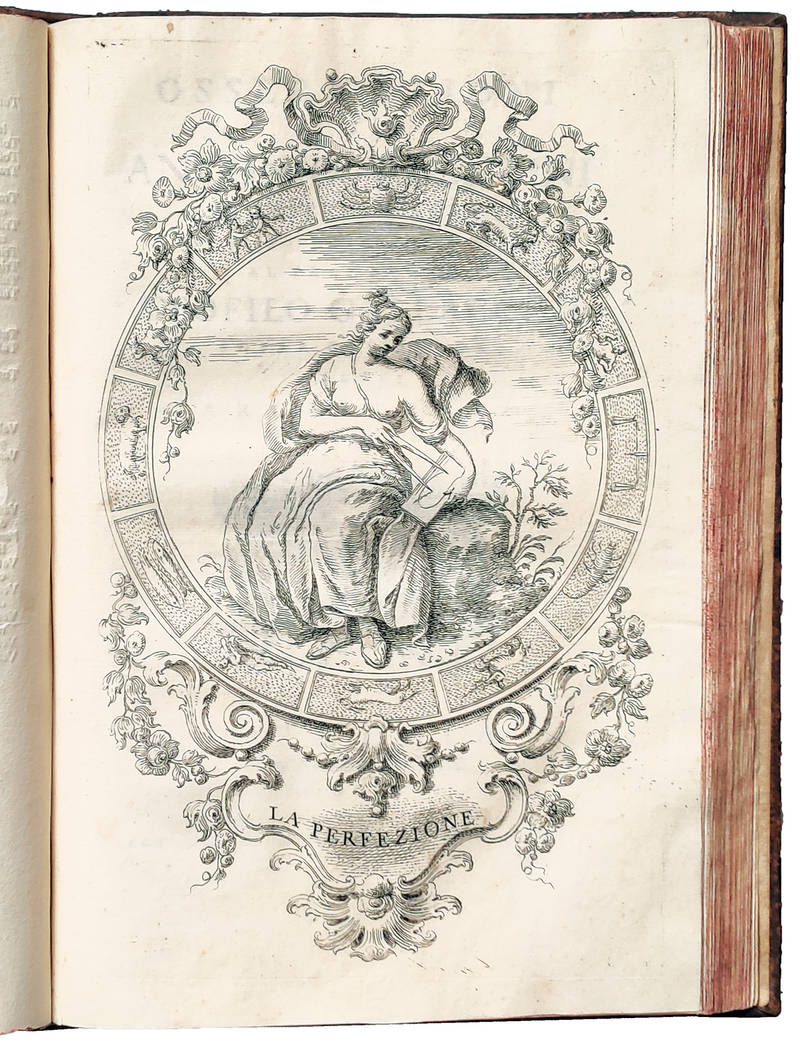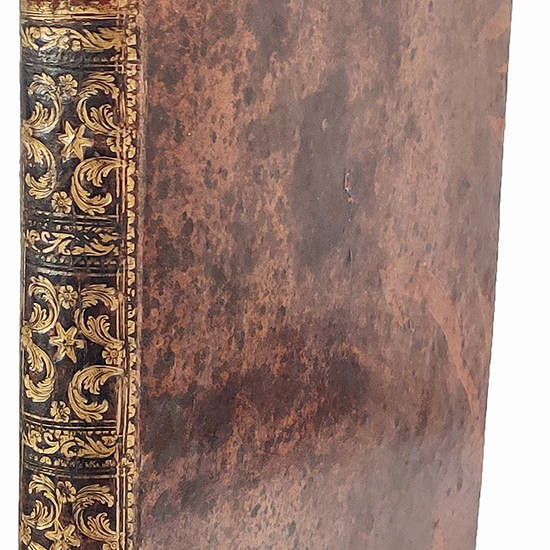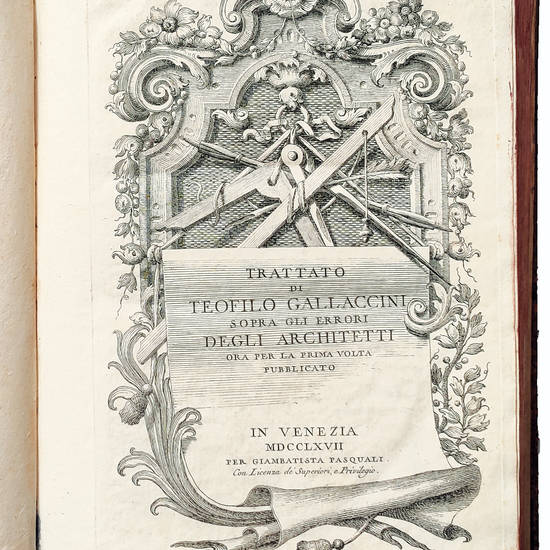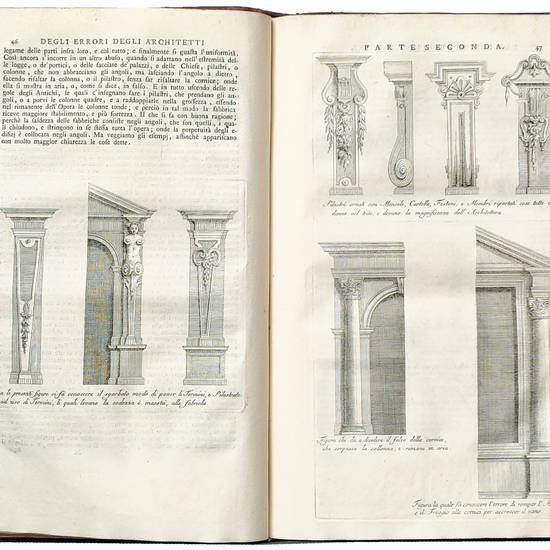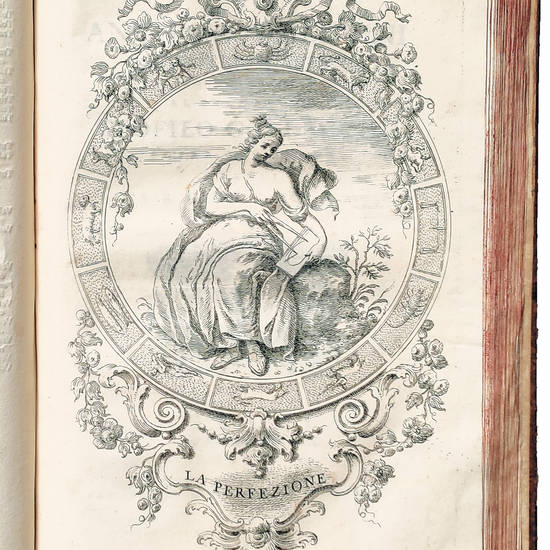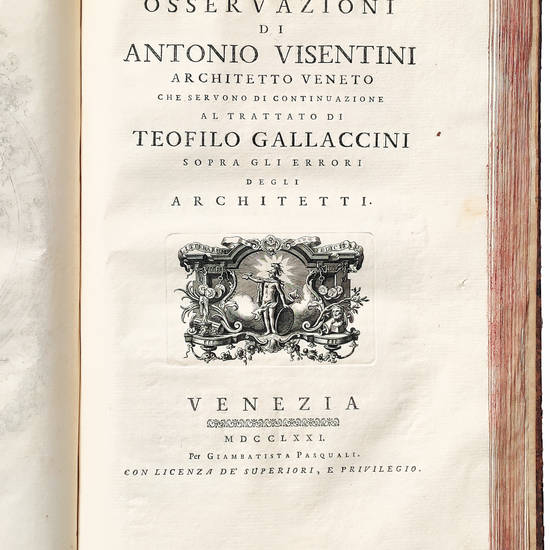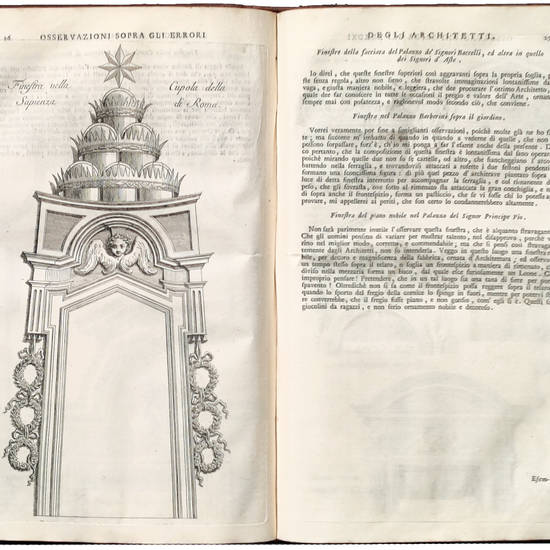(bound with:)
VISENTINI, Antonio (1688-1782). Osservazioni di Antonio Visentini architetto veneto che servono di continuazione al Trattato di Teofilo Gallaccini sopra gli errori degli architetti. Venice, Giambattista Pasquali, 1771.
Two works in one volume, folio (324x220 mm). Gallaccini: XII, 81, [1 blank] pp. Etched title plate with title in ornamental cartouche surrounded by drawing instruments and 25 unnumbered etched illustrations by Antonio Visentini in the text. Visentini: Etched frontispiece showing the allegory of Perfection among the zodiac signs, VII, [1], 141, [1] pp. Lacking the final blank. Engraved printer's device. 61 unnumbered full-page etched illustrations included in pagination. Contemporary mottled calf, gilt spine with morocco lettering piece, red edges (slightly worn and rubbed). Some minor marginal foxing, but a very good, clean copy.
I. First edition. “The manuscript on which this edition is based - dated 1625 and entitled ‘Degli errori degli architetti' - was dedicated by its author, the polymath Teófilo Gallaccini, to Giulio Mancini, physician to Pope Urban VIII. This work on architecture was only one of Gallaccin's many writings, which included treatises on philosophy, medicine, astronomy, mechanics, and military architecture, all unpublished. Born in Siena in 1564, Gallaccini studied at the local university and graduated in 1583. He then practiced as a physician at the hospital of Santa Maria della Scala and pursued anatomical studies. In 1590 he went to Rome, returning to Siena in 1602 and frequenting the Accademia degli Intronati and the Filomati, where he lectured on historical and literary subjects. In 1621 he was appointed reader in mathematics at the university of Siena by Cosimo II de' Medici, grand duke of Tuscany; after 1623 he also taught logic and philosophy. The biography of Gallaccini published in the Trattato was composed in 1759 by Giovanni Antonio Pecci, a compatriot who probably owned several of Gallaccini's manuscript studies. By 1761 Gallaccini's manuscript (now at the British Library, K. 281) had found its way into the collection of Consul Joseph Smith in Venice, who sponsored its publication by Giambattista Pasquali in 1767. This Venetian edition was illustrated by Antonio Visentini, best known for his etchings after Canaletto, whose images exemplified the architectural licenses deplored in the text. Visentini was encouraged by Smith and Giovanni Poleni to publish a continuation of Gallaccini's treatise, which he did in 1771, probably assisted by his students, as he was eighty-three at the time. The vividness of Visentini's illustrations in the Osservazioni is such that it exalts the architecture that in the text is severely criticized […] The plates for the Venetian edition of the Errori are elaborately rococo […] Organized in three parts, Gallaccini's ‘errors' deal exclusively with architectural mistakes. In part I, which is comprised of eight chapters, he examines issues that precede construction, such as poor selection of site, poor choice of materials, poor choice of builders, time, and design. Part II, in ten chapters, takes up errors of construction, while part III, divided into nine chapters, pertains to post-construction problems. Contrary to the positive advice offered in previously published treatises, Gallaccini considers the negative results of misguided choices regarding site location and materials of construction, including a long discourse on poor bricks and sand. His chapter on builders, described as greedy, dishonorable, uneducated, and undisciplined, reads like the nightmare of a would-be homeowner” (The Mark J. Millard Architectural Collection, Volume IV: Italian and Spanish Books, Fifteenth through Nineteenth Centuries, Washington DC-New York, 2000, pp. 161-162, no. 43).
II. First edition. “Among Visentini's publications is the Osservazioni che servono di continuazione al trattato di Teófilo Gallaccini, where he expanded the ideas of the seventeenth-century Sienese physician. In this book, his numerous theories, dispersed throughout the earlier manuscript writings, are conclusively treated. Visentini underlines the difference between neoclassicism and the baroque, locating it in the taste for scenographic architecture, a design concept that he considered intolerable. He declared that the illusionistic treatment of materials could no longer be condoned, that stone must be allowed to look like stone rather than wood or fabric […] Visentini's Osservazioni, divided into two parts, seem to be in agreement with Gallaccini. He first criticizes Roman architecture, finding fault with Saint Peter's, then disapproving of the 1747 restoration of the Pantheon by Paolo Posi during which the whitewashing of the interior had been considered, and moving on to Andrea Pozzo's works and Bernardo Vittone's treatise. According to Visentini, Vittone, Posi, and Pozzo ‘ruined everything in architecture'. After Pozzo, architects gave themselves over to ‘veritable seminars of errors' […] Having ranted in this manner about the errors of Roman architects whose work he considers rife with licenses and silly jokes, Visentini turns to Venice. As in his writing about Rome, he criticizes numerous details, including the abuse of spiral columns. In Venice he singles out for particular criticism the church of Santa Maria dei Miracoli, Michele Sanmichele's palace for the Grimani, and all of Baldassare Longhena's work. His principal bête noire is Giorgio Massari, which allows him to refer wittily to other architects who have fallen into error as ‘Massarino'. Even neo-Palladian stalwarts like Antonio Gaspari and Andrea Tirali do not escape his accusations […] Visentini's Osservazioni brought together his dispersed earlier theories, previously taken up in various unpublished manuscripts” (Millard Coll., op. cit., pp. 475-477, no. 154).
Gallaccini: Italian Union Catalogue, IT\ICCU\VIAE\000369; Berlin Katalog, 2636; Cicognara, 513; Comolli, IV, 252-258; Fowler, 133; Visentini: Italian Union Catalogue, IT\ICCU\VIAE\000370; Berlin Katalog, 2640; Cicognara, 514; Comolli, IV, 257-258; Fowler, 390.
[11781]



